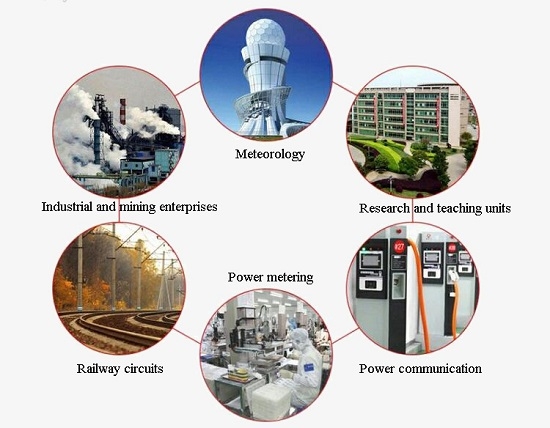An LCR meter is a type of electronic test equipment used to measure the inductance (L), capacitance (C), and resistance (R) of an electronic component. In the simpler versions of this instrument the impedance was measured internally and converted for display to the corresponding capacitance or inductance value. Readings should be reasonably accurate if the capacitor or inductor device under test does not have a significant resistive component of impedance. More advanced designs measure true inductance or capacitance, as well as the equivalent series resistance of capacitors and the Q factor of inductive components.sisco online shop will go into detail about the LCR meter.
Operation
Usually the device under test (DUT) is subjected to an AC voltage source. The meter measures the voltage across and the current through the DUT. From the ratio of these the meter can determine the magnitude of the impedance. The phase angle between the voltage and current is also measured in more advanced instruments; in combination with the impedance, the equivalent capacitance or inductance, and resistance, of the DUT can be calculated and displayed. The meter must assume either a parallel or a series model for these two elements. An ideal capacitor has no characteristics other than capacitance, but there are no physical ideal capacitors. All real capacitors have a little inductance, a little resistance, and some defects causing inefficiency. These can be seen as inductance or resistance in series with the ideal capacitor or in parallel with it. And so likewise with inductors. Even resistors can have inductance (especially if they are wire wound types) and capacitance as a consequence of the way they are constructed. The most useful assumption, and the one usually adopted, is that LR measurements have the elements in series (as is necessarily the case in an inductor's coil) and that CR measurements have the elements in parallel (as is necessarily the case between a capacitor's 'plates'). Leakage is a special case in capacitors, as the leakage is necessarily across the capacitor plates, that is, in series.
An LCR meter can also be used to measure the inductance variation with respect to the rotor position in permanent magnet machines. However, care must be taken, as some LCR meters will be damaged by the generated EMF produced by turning the rotor of a permanent-magnet motor; in particular those intended for electronic component measurements.
Types of LCR Meter
Handheld LCR meters
They typically have selectable test frequencies of 100 Hz, 120 Hz, 1 kHz, 10 kHz, and 100 kHz for top end meters. sisco offers this type of Handheld LCR Meter, 100Hz~100kHz. The display resolution and measurement range capability will typically change with the applied test frequency since the circuitry is more sensitive or less for a given component (i.e., an inductor or capacitor) as the test frequency changes.
Benchtop LCR meters
Benchtop LCR meters sometimes have selectable test frequencies of more than 100 kHz, with the high end Keysight E4982A operating up to 3 GHz. They often include options to superimpose a DC voltage or current on the AC measuring signal. Lower end meters might offer the possibility to externally supply these DC voltages or currents while higher end devices can supply them internally. In addition benchtop meters typically allow the usage of special fixtures (i.e., Kelvin wiring, that is to say, 4-wire connections) to measure SMD components, air-core coils or transformers.
Applications of LCR Meter
Component Testing
Characterizing passive components: LCR meters are commonly used to measure the values of resistors, capacitors, and inductors, helping to verify their specifications and quality.
Sorting and grading components: LCR meters are used in production and quality control to sort and grade electronic components based on their electrical characteristics.
Circuit Debugging and Analysis
Troubleshooting circuits: Engineers and technicians use LCR meters to diagnose and identify faulty components in electronic circuits, such as open or shorted components.
Determining impedance: LCR meters help analyze the impedance of components or entire circuits at specific frequencies, aiding in filter design and matching circuits.
Passive Filter Design
Designing passive filters: Engineers use LCR meters to accurately measure inductance, capacitance, and resistance values to design and tune passive filters like low-pass, high-pass, and band-pass filters.
Inductor and Transformer Testing
Characterizing inductors and transformers: LCR meters can determine inductance, winding resistance, and quality factor (Q) of inductors and transformers, essential for power supply design and RF applications.
Capacitor Testing
Capacitor testing: LCR meters help measure capacitance values, equivalent series resistance (ESR), and dissipation factor (tanδ) in capacitors, which is crucial for power electronics and RF applications.
PCB Characterization
PCB trace and ground plane impedance: LCR meters are used to measure the impedance of PCB traces and ground planes, aiding in signal integrity and high-frequency design.
Material Characterization
Dielectric material testing: LCR meters can evaluate the dielectric properties of materials, which is useful in applications like material research, quality control, and the design of capacitors and insulators.
RF and Microwave Applications
RF component testing: In RF and microwave engineering, LCR meters help characterize and measure the impedance of components used in RF circuits, such as antennas, transmission lines, and filters.
Education and Training
Learning and teaching tool: LCR meters are used in educational institutions to demonstrate and teach the principles of passive components and circuit analysis.
Quality Control and Manufacturing
Production line testing: LCR meters are employed in manufacturing facilities to ensure the quality and consistency of electronic components and products.
LCR meters are widely used in fields such as electronics testing, quality control, research and development, and the design and maintenance of electronic circuits and systems. The precise measurement capabilities of LCR meters make them essential tools for evaluating and characterizing passive electronic components.

